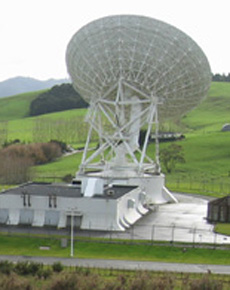Science stars to shine at astronomy conference in Auckland

An array of top international scientists including the inventor of Wi-Fi and the astronomer who downgraded Pluto converges on Auckland next week for the SKANZ 2012* conference hosted by AUT University.
Wi-Fi inventor Dr John O’Sullivan of Australia’s CSIRO (Commonwealth Scientific and Industrial Research Organisation) will speak at the conference which aims to foster collaboration between Australian and New Zealand scientists and engineers to realise the exciting potential of the SKA (Square Kilometre Array) project.
Also addressing the conference will be Dr Ron Ekers, the man who was instrumental in downgrading Pluto as a planet in 2006 in an historical International Astronomical Union general assembly in Prague. Originally classified as the ninth planet from the Sun, Pluto was downgraded to a dwarf planet, making it the second largest dwarf planet in our solar system after Eris.
The SKA is an internationally funded $4 billion project to build the world’s largest radio telescope comprising 3,000 radio telescope dishes spanning thousands of kilometres. This telescope will be capable of looking so far into deep space that it will essentially look back in time, to the origins of the universe.
New Zealand and Australia are shortlisted with a Southern African consortium to host the telescope which would provide hundreds of science and IT jobs over more than 50 years and boost local IT and telecommunication industries.
Over the past six years New Zealand and Australian radio astronomers and engineers have been working together on a SKA prototype, experimental observations, and correlating resulting data in real time. At the conference they will further discuss various pathways to SKA science in Australasia.
A decision on where SKA will be hosted (Australasia or South Africa) will be announced in March-April this year.
AUT University erected New Zealand’s first, and only, radio telescope dish in Warkworth in 2008. The $1 million dish is linked to New Zealand’s most powerful super computers, enabling AUT’s Institute of Radio Astronomy and Space Research (IRASR) to receive and process enormous amounts of data from deep space for cutting-edge research in astrophysics and earth science.
Through its link to the global geodetic network of radio telescopes and to New Zealand’s GPS network PositioNZ (in collaboration with LINZ and GNS Science) it has the potential to measure the rate of movement of the Australasian and Pacific tectonic plates upon which New Zealand sits.
Since 2008, AUT’s IRASR has been carrying out joint experiments with CSIRO, following the incorporation of AUT’s radio telescope into a set of Australian radio telescopes.
*SKANZ 2012: Pathways to Square Kilometre Array (SKA) Science in Australasia.